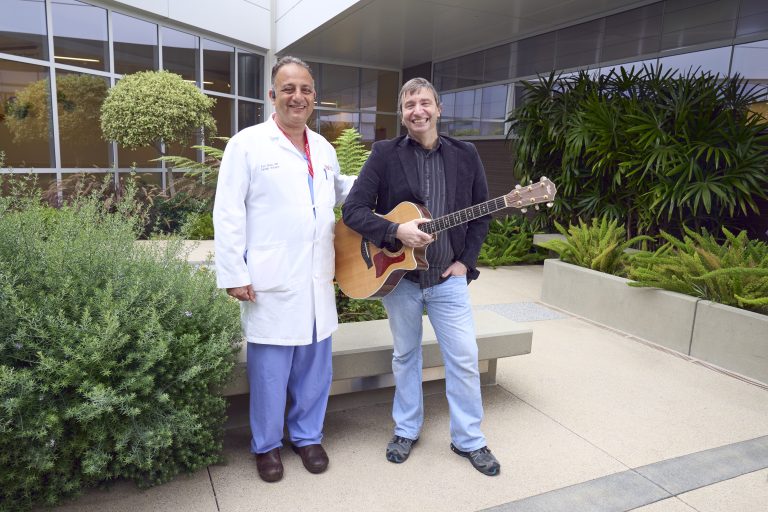The emergency stroke patient needed rapid treatment, and a critical first step involved the Torrance Memorial Medical Center stroke team administering a thrombolytic, or clot-busting drug. The treatment typically would not have been an option—guidelines stipulate a narrow time window to receive the medication, and that window had closed.
But thanks to close coordination between care teams at Torrance Memorial and Cedars-Sinai, and an affiliation bringing additional collaboration, multidisciplinary expertise and research opportunities to the South Bay, the patient was able to join an on-the-spot clinical trial testing an expanded timeframe for the study drug.
In the five years since the affiliation, local patients with a wide range of neurological conditions and emergencies have benefited from advanced specialty care, right in their backyard.
Patients at Torrance Memorial Lundquist Neurosciences Institute have access to world-class treatment options thanks to new state-of-the-art technology, the availability of advanced procedures and a wide range of clinical trials. Additionally, an expanded team of specialists from both hospitals—neurosurgeons, neuroradiologists, neuro-oncologists, neurohospitalists, stroke code nurses, movement disorder specialists, brain tumor experts and more—delivers compassionate care, treating every patient like family.
“We’re all rowing in the same direction to give our patients the very best care,” said Shlee S. Song, MD, director of the Comprehensive Stroke Center and the Telestroke Program at Cedars-Sinai. “We have a streamlined system in place, with good communication and a familiarity and ease with each other that is about trust and mutual respect.”
And those ties are only growing stronger.
Comprehensive Stroke Center
A strong partnership between Torrance Memorial and Cedars-Sinai existed years before the formal affiliation, with the development of the Telestroke Program overseen by Song.
The Telestroke Program provides 24/7 stroke coverage for the South Bay, giving Torrance Memorial Emergency Department physicians immediate access to Cedars-Sinai neurologists through teleconferences. Cedars-Sinai physicians, working as if they were right at the bedside, conduct exams, interpret scans, and diagnose and make treatment recommendations.
The program has grown rapidly, with approximately 800 annual consultations currently—up from around 350 in 2016.
Care for stroke, a leading cause of death in the U.S., has continued to advance, said Zachary Gray, MD, medical director of the Emergency Department at Torrance Memorial.
“After the formal affiliation, we leveraged our existing relationships with stroke neurologists at Cedars-Sinai to help us achieve Comprehensive Stroke Center certification—the highest possible,” Gray said.
Cedars-Sinai neurosurgeons and Torrance Memorial staff continued collaborating, working together on angiogram imaging tests, thrombectomies (clot removal surgery) and other highly specialized procedures necessary to receive Comprehensive Stroke Center designation.
Last year, Torrance Memorial performed more thrombectomies than Cedars-Sinai.
Building the Bench
The affiliation also has brought additional staff who are driving improved comprehensive care.
New neurohospitalists—vascular stroke-trained neurologists who oversee the care of hospitalized stroke patients as well as those with other neurology needs—have joined the Torrance Memorial team. And stroke code nurses have joined the Emergency Department, helping conduct bedside patient evaluations.
“Stroke patients don’t just get one doctor—they get a massive team,” said Derek Berz, senior vice president and chief operating officer at Torrance Memorial. “There’s so much more that we can now offer.”
Collaboration is further evidenced in stroke committee meetings, where conference rooms are brimming with multidisciplinary team members, including those from anesthesiology, rehabilitation and cardiac surgery.
Paula Eboli, MD, medical director of Endovascular Neurosurgery at Lundquist Neurosciences Institute, joined Torrance Memorial from Cedars-Sinai after the affiliation and helped build the neurosurgery team.
“The hospitals began their collaboration on the stroke side, but our South Bay patients’ neurological needs go beyond that, so we now have the expertise of specialists in movement disorders, spine, aneurism repair and brain tumor resection,” Eboli said.
Shared resources across the system benefit the community.
Cedars-Sinai subspecialists help fill needs on the ground in the South Bay: Patients with Parkinson’s disease can see a visiting movement disorders specialist and be evaluated for deep-brain stimulation treatment. And Cedars-Sinai specialists in spine surgeries and brain tumor resections assist Eboli.
“Surgeons we’ve recruited have expertise in brain tumors and complex intracranial disorders that would normally be transferred out to a specialty center but are now done at Torrance Memorial,” said Keith L. Black, MD, chair of the Department of Neurosurgery and the Ruth and Lawrence Harvey Chair in Neuroscience at Cedars-Sinai. “We want to continue expanding our endovascular and neurovascular capabilities and tumor and neuro-oncology capabilities, and we want to offer more brain tumor trials at Torrance Memorial.”
On the Horizon
Among other goals for Torrance Memorial: introducing a dedicated program (typically only found at a major neuroscience center) for patients with Parkinson’s. It’s about 75% complete.
On the horizon for stroke: earlier detection for patients with subtle symptoms, improved treatments for those with brain-bleed strokes and advancements in rehabilitation. An additional neurovascular interventional suite with the latest and greatest technology is currently being built to further expand diagnosis, treatment and expert stroke care.
Since adding a neurosurgical component to the spine program, the team aims to complete more complex cases and earn additional certifications.
“Our foot is on the gas pedal to stay current on the latest research and available treatments available and to have the right team members and the right equipment, and we are able to do all that we’re doing because of this collaboration,” Berz said.
Gray added that the success of the affiliation can serve as a model for other service lines, saying, “That’s one of the most exciting things in the longer term.”
That excitement pervades the continued dedication to unparalleled teamwork and top-level treatment.
“I would trust our team to care for my own family members,” Song said, “whether at Cedars-Sinai or Torrance Memorial.”









